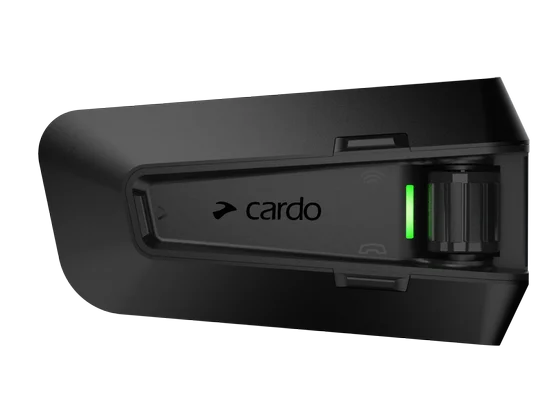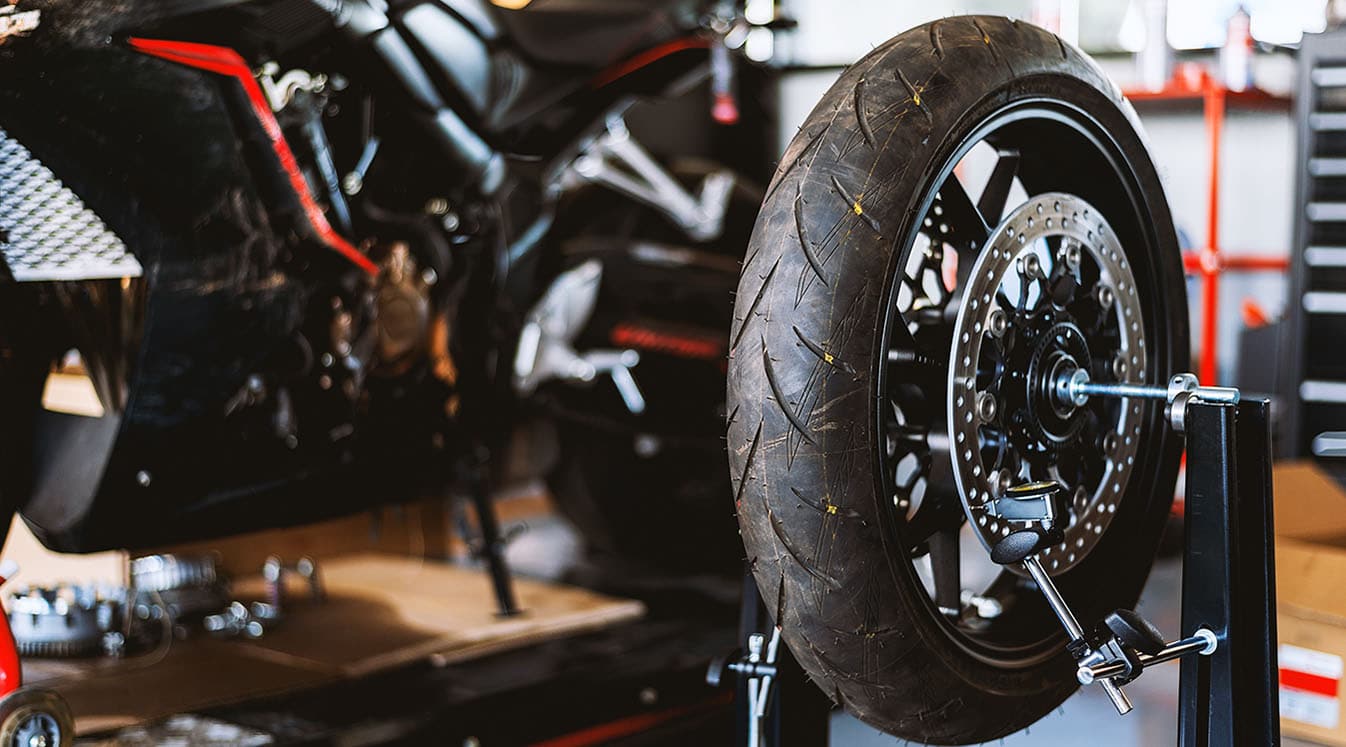Motorcycles typically outlast the tires that keep them moving. The rubber that meets the road will gradually break down and lose traction, reducing your ability to steer.
Motorcycle tires require special consideration that differs from car tires. Understanding tire lifespans and tire wear is essential for every rider. How long your tires last depends on several factors, including how you ride, the PSI level and terrain type. Recognizing signs of wear and maintaining your tires can extend their lifespan, keeping you safe on the road. Use this quick guide to learn how to assess your tires and properly care for them.
How Motorcycle Tires Wear Out
The more you ride, the faster your tires will wear out. Little by little, the thick rubber tread will get worn away whenever your tires hit the road. Every stop, every turn and piece of debris that you run over wears down the tread. The friction and heat from the road will degrade the material, making it more susceptible to punctures and leaks. ea
For any pair of tires, it’s only a matter of time before the tread surface becomes worn enough that it no longer gives you safe traction on the road. However, the rubber in motorcycle tires won’t last forever — even if you don’t ride as much.
That’s because rubber, like many other materials, experiences the natural chemical process called oxidation when exposed to air. As your tires oxidize, they become harder and more brittle, which reduces their traction and other performance factors.
So, How Long Do Motorcycle Tires Last?
There’s no hard and fast rule on how long a pair of tires will last on your bike. However, a tire over five years old is generally no good, even if nobody’s been riding on it. We’ll talk about how to identify an old tire shortly.
As for how long a tire will last, it all depends on how much you ride and your riding style. Someone who rides at high speeds with aggressive cornering and acceleration will wear out their tires faster than a more relaxed rider.
Where you ride can be just as influential. Running over gravel, twigs and rocks wears down the rubber unevenly. These objects have sharp edges that can puncture the rubber or leave dents that attract more debris.
Note that rear tires tend to wear out faster than front tires since they provide most of the motorcycle’s power and control. Many motorcyclists change rear tires twice before they have to replace their front tire.
Explore the Road with a Motorcycle Bluetooth HeadsetAre My Motorcycle Tires Still Good?
First, you should find out whether your tires are more than five years old, especially if you just bought the bike. There’s an easy way to determine this, and you just have to know how to read a motorcycle tire to do it.
-
Look at your tire’s sidewall and find where it says “DOT” followed by a long string of numbers.
-
Check the last four digits of that number series to find the year and week that your tire was manufactured.
-
The first two digits represent the week of the year that the tire was made, from 1 to 52. For example, the number 27 means that the tire was made in the 27th week of the year.
-
The second number represents the last two digits of the year the tire was made. For example, the number 18 means the tire was made in 2018.
Any tire over five years old needs to be replaced. Don’t assume that tires are brand new, even if you bought them from a dealership.
Don’t wait for your tire to reach the five-year mark before replacing it. Check your tires regularly for worn treads, weak spots and debris that limit their lifespan.
Understanding Tire Pressure and Its Impact
Maintaining the correct tire pressure is beneficial for the performance and safety of your bike tires as well as longevity. Proper tire pressure ensures that your tires wear evenly, extending their lifespan and preventing issues like uneven wear. Using a tire pressure gauge, regularly check your tires to ensure they are inflated to the manufacturer's recommended PSI. Overinflated or underinflated tires can lead to poor handling, reduced traction and increased risk of blowouts. Adjusting tire pressure based on riding conditions, such as road type and weather conditions, can also enhance your riding experience.
Incorrect tire pressure can cause various problems, including bulges and reduced performance, even in tubeless tires. Riding on tires with improper pressure can accelerate tread wear and compromise your bike's stability. Regular checks and adjustments help maintain optimal performance and safety. Properly inflated tires improve fuel efficiency and provide a smoother ride, making your motorcycle safer and more enjoyable to ride. Keep an eye on your tires to avoid costly repairs and ensure a longer, safer ride.
When Should I Replace My Motorcycle Tires?
There are reasons other than age to replace a motorcycle tire. Get a new tire on your bike immediately if:
-
The tire’s built-in wear indicators are showing.
-
The tire has any kind of rip, cut or puncture.
-
The tire’s treads are worn down to 1/32nd of an inch or less. (Use the penny test.)
If only one tire on your motorcycle needs replacement, replacing just that one is usually fine. However, riders who are switching to a new brand or style of tire will usually want to replace both to avoid the potential handling issues of a mismatched tire set.
Tips and Tricks for Motorcycle Tire Care
For proper maintenance and care, follow these helpful tips:
-
Before each ride, check your tires for cracks or punctures.
-
Make sure your tires are always inflated to the manufacturer’s recommended PSI.
-
Avoid storing your motorcycle (or your tires) in direct sunlight if possible, as this can reduce the lifespan of tire rubber.
-
Go easy on a new pair of tires and give them some time to break in without hard cornering or excessive revs.
-
Ride on smooth, paved surfaces whenever possible.
Choosing the Right Tires for Your Motorcycle
Choosing the right type of tire for your motorcycle is essential for supporting performance and safety. Different motorcycles and riding styles require specific tires, ranging from sport tires for high-speed performance to off-road tires designed for rugged terrain. Consider your usual road conditions or other driving environments when selecting a tire. The tread depth and tread pattern are crucial factors — deeper treads provide better grip on loose surfaces, while slicker tires offer more contact with paved roads. Additionally, deciding between tubeless and tube tires depends on your preference for convenience and puncture resistance.
When purchasing a new set of tires, keep in mind the tire size and tire age. Even a tire with minimal tread wear can be unsafe if it's too old, as the rubber degrades over time. Check the manufacturer's recommendations for your specific motorcycle model, including the ideal size for long motorcycle rides. Regularly inspect your tires for signs of wear and damage caused by varying road surface conditions. By selecting the right tires and maintaining them properly, you can enhance your riding experience and ensure your safety on the road.
The Dangers of Riding with Bad Tires
Riding on tires more than five years old increases the risk of a blowout and makes it harder to stay in control of the bike. When the tire suddenly loses air, it can cause you to swerve or suddenly lose power, leading to a traffic accident.
Wear the proper safety equipment to reduce your risk of injury in a blowout, including a full-face or half-face helmet with goggles, gloves and riding boots. Use Bluetooth helmet intercoms to connect wirelessly with your group. You never know when your tire could get a flat or lose traction. Use a wireless headset to contact one of your fellow riders in an emergency so they know not to leave you behind. The device forms a direct link with each member of the group to prevent disconnection when the formation changes. Coordinate with your crew to find a safe place to pull over and address the issue, either by changing the tire or calling for roadside assistance.
Making Your Motorcycle Tires Last
Nothing affects performance and safety like the quality of your tires. Do your part to protect your treads from unnecessary wear and check your tires regularly for damage to avoid a blowout. For more tips on keeping your bike in great shape, see our ultimate guide to motorcycle maintenance.
Motorcycle Maintenance: The Ultimate Guide




